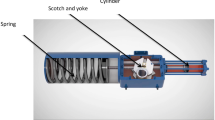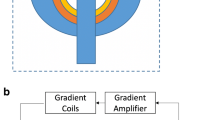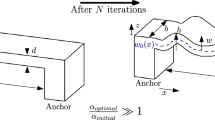Abstract
The objective of this paper is to find the relatively low-frequency (200–2,000 Hz) mode shapes of a single-winding gradient coil cylinder with intermediate wall thickness. The dynamic behavior of a gradient coil cylinder plays a crucial role in determining and controlling the vibroacoustic performance of magnetic resonance imaging (MRI) scanners. Modal analyses of the gradient coil cylinder were carried out under different boundary conditions to obtain the various mode shapes. Theoretical modes, predicted by using modified Love’s governing equations, and numerical modes simulated using a finite element method show close agreement with experimental modal results and reveal the mode shapes for both free-end and fixed-end boundary conditions. These results were further compared to in situ measurements of the mode shapes of the gradient coil cylinder insert during scanning in a 4 Tesla MRI. The general agreement among the analytical, numerical, and experimental mode shapes indicates that a linear combination of basic beam vibration and ring vibration patterns occupy the dynamic vibration modes in the low frequency range. The in situ vibration measurements show that the forcing function developed by the distributed Lorentz forces on the surface of the single-winding gradient coil results in predominantly beam-type bending mode patterns in the low frequency range.
Similar content being viewed by others
References
Mechefske CK, Yao G, Wang FL (2004) Vibration and acoustic noise characterization of a gradient coil insert in a 4 T MRI. J Vib Control 10:861–880
Hedeen RA, Edelstein WA (1997) Characterization and prediction of gradient acoustic noise in MRI imaging. Magn Reson Med 37(7):7–10
Mechefske CK, Yao G, Li W, Gazdzinski C, Rutt BK (2004) Modal analysis and acoustic noise characterization of a 4T MRI gradient coil insert. Concepts in Magn Reson B Mag Reson Eng 22B:37–49
Shao W, Mechefske CK (2005) Analyses of radiation impedances of finite cylindrical ducts. J Sound Vib 286(1–2):363–381
Edelstein WA, Hedeen RA, Mallozzi RP, El-Hamamsy SA, Ackermann RA, Havens TJ (2002) Making MRI quieter. Mag Reson Imag 20:155–163
Mechefske CK, Geris R, Gati JS, Rutt BK (2002) Acoustic Noise Reduction in a 4T MRI Scanner. Magn Reson Mater Phy 13:172–176
Yao G, Mechefske CK, Rutt BK (2004) Characterization of vibration and acoustic noise in a gradient-coil insert. Magn Reson Mater Phy 17:12–27
Wang FL, Mechefske CK (2005) Modal analysis and testing of the thin-walled gradient cylinder model. Concepts Mag Reson B Mag Reson Eng 27B(1):34–50
Soedel W (2004) Vibrations of shells and plates, 3rd edn. Marcel Dekker, New York
Singhal RK, Guan W, Williams K (2002) Modal analysis of a thick-walled circular cylinder. Mech Syst Signal Process 16:141–153
Fersberg K (1964) Influence of boundary conditions on the modal characteristics of thin cylindrical shalls. AIAA J 2:2150–2157
Santiago JM, Wisniewski HL (1989) Convergence of finite element frequency predictions for a thin walled cylinder. Comput Struct 32:745–759
Singal RK, Williams K (1988) Theoretical and experimental study of vibrations of thick circular cylindrical shells and rings. ASME J Vib Acoust Stress Reliab Des 110:533–537
Wang FL (2006) Dynamic modeling of gradient coils in a MRI scanner. PhD Thesis, Queen’s University, Kingston, Ontario, Canada
Ewins DJ (2000) Modal Testing: Theory, Practice and Application, 2nd edn. Research Studies Press, Hertfordshire, UK
Author information
Authors and Affiliations
Corresponding author
Rights and permissions
About this article
Cite this article
Mechefske, C.K., Wang, F. Theoretical, numerical, and experimental modal analysis of a single-winding gradient coil insert cylinder. Magn Reson Mater Phy 19, 152–166 (2006). https://doi.org/10.1007/s10334-006-0038-y
Received:
Accepted:
Published:
Issue Date:
DOI: https://doi.org/10.1007/s10334-006-0038-y




